MORE ASBESTOS IN NEW ZEALAND.
(NOW IT LOOKS LIKE THERE WILL BE AN ONGOING PROBLEM IN CHRISTCHURCH.)
----------------
11th May 2011
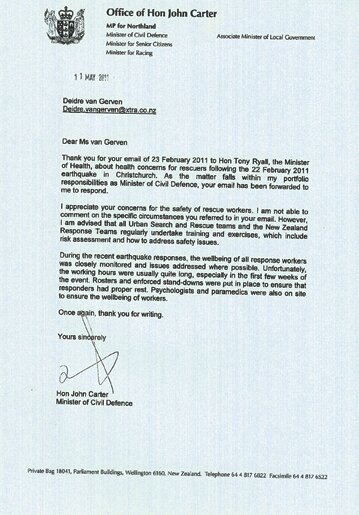
------------------------------
I wrote this letter to Tony Ryall not John Carter, as I was concerned about the long term health
of all the people who were in Christchurch at the time of the earthquake. At that time Tony Ryall was the Minister of Health. The appropriate minister to deal with ongoing health problems that will show up not immediately, but over the next 20-40 years,(give or take a few years). Obviously someone else does not understand the English language or chooses to pass the buck once again.
I believe that at that time everyone involved should have been told to inform their doctors of their exposure so that it would be included in their health records and that they would have had regular check-ups through ACC. Remember many people who were down in Christchurch came from other districts and even other countries. But I suppose that would have been too much work
In the letter John Carter says he is unable to comment on specific circumstances I referred to in my letter Of course he can't. That was why this letter was sent to the Minister of Health, and should have been answered by him The enforced stand-downs, proper rest, psychologists and paramedics was okay for the civil defence at that time. but were absolutely useless as far as my questions went. And that was the long-term welfare of all those people Still by the time these diseases rear their ugly heads, those in charge of this problem will be long dead
---------------------
On to More Problems With Asbestos,
--------------------
Plasterboard will be used to encase potentially deadly asbestos in more than 4000 earthquake-damaged Christchurch homes due for repair. Canterbury District Health Board medical officer of health
Alistair Humphrey says the Earthquake Commission (EQC) decision not to remove the asbestos creates a "landmine". Christchurch-based Labour MP Ruth Dyson, in a statement on Wednesday, said the asbestos looked set to create a potentially fatal legacy, akin to the trail of events which culminated in the huge loss of life with the CTV building collapse.
Leaving asbestos in houses contravened EQC's own guidelines, she said. It was also unfair that home owners could not decide to have the asbestos removed, and future owners could be unaware of the asbestos.
"This is obviously about saving money, but at what cost? It is risking lives. The practice must stop."
Ms Dyson said the matter needed an urgent response from the government. But a spokesman for Duty Minister Anne Tolley said it was an operational matter for EQC, and the minister would not comment. Dr Humphrey told The Press the encasement practice is a serious health risk, and homeowners selling their house could try to hide the presence of the now discredited building material. "We have an opportunity to make sure houses are safe.
They should just take it all out. "It is a landmine sitting there which we won't know about."Prolonged, chronic exposure to disturbed asbestos can cause various lung diseases, including cancer, but can take decades to develop. But EQC home repair programme manager
Reid Stiven said encasing followed health guidelines. Asbestos ceilings were encased only when they were not damaged or deteriorating, he said.
"Enclosing is a reliable method for ensuring asbestos is safely contained," he told The Press.
------------------------------
updated version.
Charley Gates.
Asbestos in the ceilings of more than 4000 earthquake-damaged homes will be left encased behind plasterboard a situation Canterbury's leading medical adviser says is a health "landmine".
The Earthquake Commission (EQC) estimates 43,000 Christchurch homes due for quake repairs
could contain asbestos. In about 10 per cent of cases, asbestos in ceilings has been "encased"
behind plasterboard instead of being removed. Homeowners will be told if this is done in their homes, but there are concerns encasement may encourage them to hide the information.
Canterbury District Health Board medical officer of health Alistair Humphrey says the practice is a serious health risk. "I personally feel encasement is not a good thing to do under any circumstances," he said. "It disguises the fact that it is there. We have an opportunity to make sure houses are safe. They should just take it all out. It is a landmine sitting there
which we won't know about."
------------------------------
No Need To Tell of Asbestos
(Marc Greenhill and Charlie Gates.
10/01/2013
Christchurch homes with asbestos concealed by earthquake repairs could be sold without the buyer being aware the hazardous substance is present. The Earthquake Commission (EQC)
estimates 43,000 Christchurch homes due for quake repairs could contain asbestos.
In about 10 per cent of cases, asbestos in ceilings will be "encased" behind plasterboard instead of being removed during quake repairs. Homeowners are not obliged to inform potential buyers about the presence of asbestos in their property. Canterbury District Health Board
medical officer of health Alistair Humphrey and Christchurch homeowners have called for asbestos finds to be recorded on council land reports. Humphrey said a public register should be kept. "If someone's just fixed a ceiling where there's been some damage to the asbestos tiles and [contractors] have covered it over, that I believe should go on the LIM (land informational memorandum), but in practice that doesn't happen and it's not likely to happen. It was unlikely homeowners would want to disclose the fact because they "might perceive it would devalue their homes", he said.
------------------------------
EQC spokesman Iain Butler said the commission advised homeowners and contractors working with asbestos, but was not required to notify other authorities. A record of properties containing asbestos was kept for internal reporting purposes. " We would be able to, theoretically, get that information, but to my knowledge we've had no requests to do that," he said.
A St Martins homeowner, who did want to be named, had asbestos contained in her ceiling
during quake repairs about six months ago. The buyers of similar homes should be notified, she said. "It gives people the choice, whether they think they're bothered or not." A Richmond homeowner whose ceiling had tested positive for asbestos said it would be "selfish and irresponsible to hide the fact when selling the house. If it's there, I think it's fair that people know about it. That's just wrong and passing your problem on to someone else," she said. This is a real health hazard. This is our house, we own it and it's our responsibility."Harcourts South Island provincial manager, Jim Davis, said real estate agents had to inform potential buyers of asbestos,
but homeowners did not. We are obliged to tell purchasers when there are aspects of the house
that would be relevant to them and could be a concern. Asbestos fits into that category. When we know there is asbestos then, in my opinion, that should be disclosed to a potential purchaser," he said Christchurch City Council customer and support manager Tracey Weston said home owners were not obliged to put asbestos on their LIM. "It is not a legislative requirement for council to proactively seek out this information, "she said. "However, asbestos would be included
on a LIM at the owner's request if they had documentation as proof", Weston said.
------------------------------
Jan 11th 2013
EQC's come out defending its operations around earthquake-damaged homes containing asbestos. It's copped criticism for encasing the toxic substance behind plasterboard, rather than removing it with some saying it could have fatal consequences to people's health. EQC's Reid Stiven says they're following policy and processes to a tee. He says everything they've done is in line with the Department of Labour and District Health Board. Reid Stiven says if the removal of asbestos in an earthquake-damaged home is appropriate, it is removed. He's confident that of the 30,000 repairs EQC's completed, they've encountered a very low number involving asbestos.
-----------------------------
Asbestos was once used in construction and can be dangerous if it is disturbed. Health experts say it is most harmful if a person is exposed to high levels of the material for a long period.
Prolonged, chronic exposure can cause various lung diseases, including cancer, but can take decades to develop. Humphrey said the encasement policy would leave "a very unfortunate legacy" for Christchurch, and he has told the EQC of his concerns. In the future, no-one will know asbestos is there. It is covered over. "At the moment, you can look and see straight away it is there," he said. "Ten years down the track, someone could decide to put down lights in a room.
They drill into [the asbestos] and put themselves at risk. You could have a little baby crawling around on a carpet for six months with asbestos in it. [Adverse health effects] would emerge only when they were in their 20s, and they will not know the source. It is a very unfortunate legacy."
------------------------------
EQC home repair programme manager Reid Stiven defended the policy. " Asbestos ceilings were encased only when they were not damaged or deteriorating, Stiven said, and homeowners were informed if asbestos was found in a property and if it would be encased. EQC always tests for the presence of asbestos where it is suspected," he said. Humphrey said landlords would be reluctant
to put asbestos on the official information record for their home, known as a land information memorandum (LIM). If you have a severely damaged house, that has asbestos in the ceiling and they encase that, do you think landlords will put that on the LIM? If they do, it devalues their house. Nobody will put asbestos on the LIM," he said. Stiven said the encasement policy
followed health guidelines.
------------------------------
"Enclosing is a reliable method for ensuring asbestos is safely contained," he said. "We are following the relevant national guidelines and the recommended practice of Canterbury Public Health. Asbestos is only a health risk where it is damaged or deteriorating, and in those cases it is removed. All of our EQC field staff and Fletcher EQR supervisors have been given training in the correct identification of asbestos. If they suspect asbestos is present, then a sample is taken and sent to testing. This is completed by an independent specialist. "The working group that developed the EQC asbestos policy was chaired by an independent health and safety consultant," he said.
------------------------------
http://www.ci.bloomington.mn.us
Where was asbestos used in older homes?
The main areas of the house where asbestos was used were in basements, attics or roofs.
As an acoustical or heat insulator, asbestos was often placed in, around or between steel beams,
water and sewer pipes, ducts, high temperature gaskets, stovepipe rings, electrical wiring, vinyl and linoleum sheet flooring, floor backing, shingles, panels, partitions and acoustic tiles.
It was also placed in the areas of heaters, boilers, furnaces, incinerators, artificial fireplaces and barbecues. These are the areas a homeowner is most likely to visually see the soft, fluffy asbestos that's white or gray. (Asbestos that was mixed into cement, siding, wall coverings, plaster, stucco, spackling, putty, caulking, vermiculite, and joint compounds is obviously not visible.)
------------------------------
Myth #1:
The number of mesothelioma cases is declining now that asbestos use is regulated.
While many uses for asbestos were banned in the mid-1970's, the risk from exposure continues to this day because of mesothelioma's long latency and incubation periods. Symptoms, most commonly affecting the lungs, can sometimes take between 10-70 years to appear making diagnosis of the disease difficult. According to Carbone, over 20 million people in the United States are at risk of developing malignant mesothelioma due to asbestos exposure. Although prior to the 1950's, mesothelioma was rare, as noted by Carbone, mesothelioma is now responsible for approximately 3,000 deaths per year in the U.S. Carbone further estimates that
mortality rates from mesothelioma will increase by 5-10% per year in most industrialized countries until about 2020. First responders to the World Trade Center terrorist attacks are now at risk of
developing mesothelioma. Asbestos was used to insulate the lower half of the first World Trade Center tower, and some studies report over 400 tons of asbestos dust was released into the air
upon the collapse of the buildings. A pattern has emerged of negative health effects among fire fighters who responded to the 9/11 tragedy. That pattern persuaded a medical advisory panel in 2012 to recommend adding mesothelioma to the list of cancers and diseases for which fire fighters and first responders should receive compensation and treatment.
------------------------------
Myth #2:
Only men over 65-years-old are diagnosed with mesothelioma. While it is true that nearly 80 percent of the mesothelioma cases are diagnosed in men, typically in their late 60's to 70's,
younger men and women are also susceptible to developing the disease. Men tend to develop the cancer more often than women due to the greater presence of men in the kinds of heavy industrial jobs such as ship building, mining and automotive repair where asbestos was prevalent.
However, the men who worked around asbestos, and brought the fibers home on their clothing,
shoes and in their hair, may have inadvertently exposed their children and spouses to the deadly toxin leading to second-hand exposure. Inhalation of the toxic asbestos fibers through second-hand exposure can lead to mesothelioma. In fact, the U.S. Environmental Protection Agency
has reported that there is no safe level of asbestos exposure. According to researchers at Brigham and Women's Hospital in Boston, Massachusetts, women tend to develop mesothelioma
at an earlier age than men, but they live longer with the disease after surgery.
----------------------
My Thoughts on this subject
10.01.2013, updated report, The Press.
--------------
Christchurch homes with asbestos, concealed by earthquake repairs could be sold without the buyer being aware the hazardous substance is present. Ms Dyson said the matter needed an urgent response from the Government. But a spokesman for Duty Minister Anne Tolley said it was an operational matter for EQC, and the minister would not comment. (EQC is a Government and Crown Entity) Once again, "passing the buck". Sliding the problem onto the EQC. This seems to be typical. If it's too hard a problem to deal with give it to someone else. Well that is not how this works. The government is the only one who can change the rules and say "no" to encasement.
------------------------------
I believe my father died from asbestosis, my sister from ovarian cancer, (asbestos in talcum powder) my husband from mesothelioma and now a brother has been diagnosed with asbestosis.
And this government is allowing asbestos, containing products to come into NZ from countries that have no regulations over asbestos. Countries that don't give a damn about the health of their own people. Countries, that allow manufacturers to make a profit regardless of who dies because of it. So many products that even the ex minister of the environment (Nick smith) could not list what they are. Could not, even see a problem with this
------------------------------
On the 30th July 2013, I sent a copy of this letter to every MP in NZ plus the mayor and each of the councillors in Christchurch and to some newspapers hoping that someone will do something about it.
-----------------------------
An Open Letter to Christchurch and New Zealand Authorities.
by Deidre van Gerven.
Lord knows we have waited long enough for the rebuilding of Christchurch. In the eighteen months since the earthquake devastated sections of Christchurch, lives have remained on hold and businesses have remained in a state of suspended animation. Frustration levels are high amongst citizens and business leaders; a recent survey found that 56% of chief executives felt insufficient progress was being made. So, it is with some sense of relief that we welcomed the news of a major international deal to rebuild Christchurch. As with most things, however,
the devil is in the detail.
The firm which has signed a memorandum of understanding with New Zealand's Arrow China State Construction Engineering Corporation. There is no doubt that the Chinese conglomerate is a world player; it was ranked the world's biggest contractor in 2012. Arrow has publicly stated that the deal will provide "access to a highly cost-effective supply chain," which will help reduce inflated prices for building materials. Arrow personnel will collaborate with Chinese colleagues with a view to sourcing some building products in China. China is the world's biggest user of
raw chrysotile asbestos and the second most important source of asbestos fiber. In 2012, China consumed 530,834 tonnes/t and produced 420,000t of asbestos; in 2011, these figures were
637,735t and 440,000t. The use of chrysotile asbestos in China is legal and the export by China
of asbestos-containing products to countries where asbestos has been banned has been documented.
This government is quite happy to allow products containing asbestos to be bought into New Zealand. In a letter received by me in October 2009. Office of Hon. Dr. Nick Smith. Minister for the Environment "There is no comprehensive list of the products that contain asbestos that may currently be imported into New Zealand. However, I can advise that the types of products that may contain asbestos are cement sheets, friction materials and articles such as clutch pads and gaskets. The situation with asbestos-containing products is different. No HSNO approval from ERMA is required"
Also in a letter received by me in February 2013, from Amy Adams, the Associate Minister for Canterbury Earthquake Recovery, wrote: New Zealand does not monitor the importation of asbestos products. As New Zealand's monitoring of imports is woefully inadequate, there are grounds for concern regarding the potential for the import of asbestos-contaminated building
products from China. What guarantees are there by Arrow International for the China State Construction Engineering Corporation that all work undertaken in Christchurch will be
carried out with asbestos-free materials. I feel that we have a right to know. July 30,
------------------------------
Reid Stevens may be following health guidelines but surely even he can see the ongoing problems that will happen if this encasement is allowed to continue. Guidelines are put in place to
cover most things but something will eventually crop up that is not really covered specifically.
Then surely in his position he has the power to use his own discretion when making a decision.
Or is he just a 'puppet' also. And remember it is not just the ceilings of houses that were built at that time that have asbestos in them. Corrugated asbestos roofs Wall claddings (external and internal) insulation and acoustic products. Asbestos mixed with a binder and sprayed round boilers, pipes that are used for water supply and sewage piping, ducts .Electrical switchboards,
Vinyl or asphalt flooring is particularly likely to contain asbestos How carefully were these handled at that time or is this what was in the truck load after truck load that travelled through suburbs (uncovered) in the middle of the night on the way to the dump.
New Zealand is made up of our very own handy man or woman" who renovate their homes and have done so probably as far back as the first settlers because they needed to. They drill into ceilings to replace light fittings little knowing the dangers that are lurking there. Asbestos fibres so minute that they can't see them floating round in the air or feel them when they breath them down into their lungs. Or as they swallow the dust which sends fibres to their abdomen. Fibres so minute that 220,000 fibres of asbestos will easily be lost in 2-3 grains of rice or 5-6 human hairs. Harcourts South Island provincial manager, Jim Davis, said real estate agents had to inform potential buyers of asbestos, but homeowners did not. We are obliged to tell purchasers when there are aspects of the house that would be relevant to them and could be a concern. Asbestos fits into that category. When we know there is asbestos then, in my opinion, that should be disclosed to a potential purchaser," he said Christchurch City Council customer and support manager Tracey Weston said home owners were not obliged to put asbestos on their LIM.
"It is not a legislative requirement for council to proactively seek out this information, "she said.
"However, asbestos would be included if they had documentation as proof", Weston said.
------------------------------
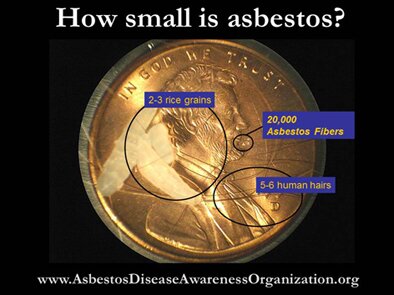
And you don't know about it because nobody has to tell you and it does not need to go in the LIM. And just remember that by the time you find out that you have an asbestos related disease
that is going to kill you those people who should have done their best to inform you will most likely be dead and not answerable to their crime. Because in my eyes that's what it is. A crime.
And now when there is a chance to prevent one of the means of asbestos exposure the EQC thinks it's okay to hide it behind plasterboard. IT IS NOT OKAY.
Let them know it's not okay. Thousands of people were exposed to the airborne toxins after the attack on the World Trade Center, including those who survived the collapse, first responders, those who lived near the towers, and even the workers who were hired to help clean up the rubble left behind. Additionally, as the debris and damaged buildings found at ground zero burned for several months after the attacks, thousands of heavy metals and carcinogens such as barium, mercury and asbestos, were released into the atmosphere Countless people exposed to the pollution are suffering from symptoms of respiratory illnesses today, years after the attacks, like difficulty breathing, coughing, asthma, and even lung cancer and mesothelioma. As the years pass, it has become obvious that more and more of our citizens have been infected with cancer and respiratory disease. While still considered to be rare instances of mesothelioma have undoubtedly increased in number. Asbestos is deemed safe if intact. But builders and home renovators are still vulnerable to exposure if they unknowingly disturb old housing materials with asbestos in them.
Mr Cosman's report also found low awareness of asbestos in the construction industry The older workers tended to think asbestos was yesterday's problem, that it had all been sorted in the 80's,and younger workers, of which there were an increasingly number in the industry, know nothing about it.
The Department of Labour said it was carrying out a wider review of asbestos handling in the workplace, which might include a ban imported asbestos products. Asbestos fibres are harmful because they are extremely small and sharp. Ordinary sized dust is caught and expelled by the body's defences before it can be breathed in to the lungs or swallowed into the stomach, but asbestos slips through. That's why it's the lungs and chest that suffer most, and sometimes the stomach. Once inside, they begin to damage the tissues. There is no known safe level of exposure to any type of asbestos. I believe that with mesothelioma the exposure to asbestos does not have to be huge
One person I know whose father worked with asbestos but was told to wear a mask. He was not told about his overalls and his wife would shake them out and wash them in the basement of their house while her six children played on the floor. She died from mesothelioma and four of her six children developed an asbestos related disease. Two of whom died from mesothelioma in their forties. So nobody can tell me that some exposure might be safe. The only safe exposure to asbestos is absolutely no exposure", whatsoever.
------------------------------
The following letter is from the
Hon, Bill Shorten, Australia.

-----------------
OFFICE OF THE HON BILL SHORTEN MP
MINISTER FOR EDUCATION
MINISTER FOR WORKPLACE RELATIONS
Our Ref MC13-003990
3rd August 2013
Ms Deidre vanGerven
[email protected]
Dear Ms vanGerven
Thank you for your email of 21 April 2013 to the Hon Bill Shorten MP, Minister for Employment and Workplace Relations, concerning the New Zealand Government's lack of action in banning the import and export of asbestos containing materials. The Minister has asked me to reply on his behalf. I am sorry to learn of the significant impact asbestos has had on you and your family.
You should be commended for supporting those with asbestos-related diseases and your work to raise awareness of the dangers of asbestos. In your email, you provide details of an incident involving the importation of asbestos containing materials in a range of equipment and components destined for Australia's resource exploration and development industry. While originating from Asia and former Soviet bloc countries, the asbestos containing materials were imported into Australia in 2010,via other countries, including New Zealand. In response to this incident, the Australian Government instigated an industry outreach program and worked closely with venture companies to prevent these prohibited goods from being imported into Australia in the first instance. This includes encouraging importers at risk of importing goods containing asbestos to seek independent certification from a laboratory accredited by the National Association of Testing Authorities that their goods are asbestos-free. Further, a working group has been formed by the Heads of Workplace Safety Authorities to examine compliance and enforcement approaches in respect of imported materials that contain asbestos, to further strengthen Australia's asbestos controls.
You may also be interested to know that the Australian Government established the Asbestos Management Review (the Review) in 2010. In response to the Review, the Government is committed to developing a plan of action for asbestos eradication, handling and awareness across Australia that aims to eliminate exposure. Parliament House Canberra ACT 2600 Telephone (02) 6277 7350 Fax (02) 6273 4134 One of the Review's recommendations was that the Australian Government continue to play a leadership role in a global campaign aimed at securing a total worldwide ban in the production and trade of asbestos and asbestos-containing products so as to contribute towards the worldwide elimination of asbestos-related diseases, and to more effectively control the entry of asbestos-containing materials into Australia. This recommendation has been accepted by the Government. More information about the Government's actions can be found at I trust that this information is helpful and thank you for bringing your concerns to the Minister's attention. Regards Ms Simone Stevenson Adviser
November 2013 Amy Adams decided To have an investigation into the products containing asbestos.
This is following on from Asbestos in New Zealand pages.
So the following letters are some I received over that time in answer to my query as to how this investigation was shaping up.
As you will see the investigation did take place but before I received any answer from Amy we had an election and I was told I would have to wait to find out who would be handling this problem from there on.
Well what do you know. The problem went back to Nick Smith.
If you remember he was the first one involved in this beginning back in 2009.
So now I'm back at the beginning again with someone who didn't do anything then and probably won't do anything now.
But we shall see
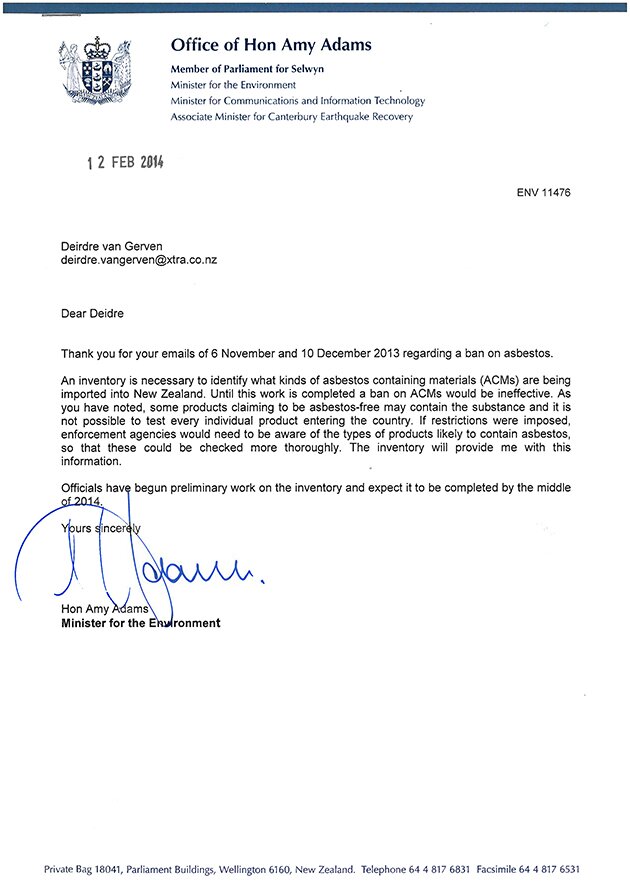
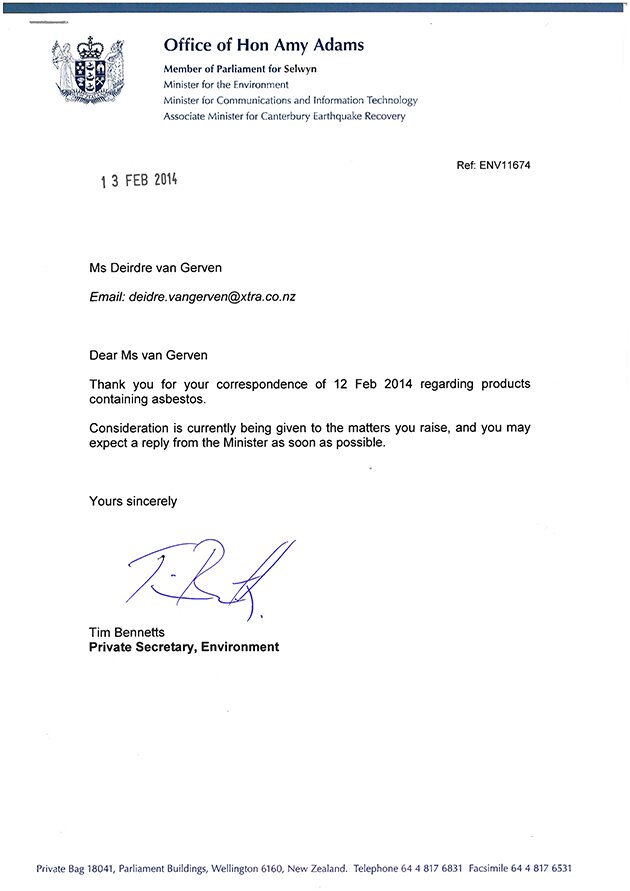
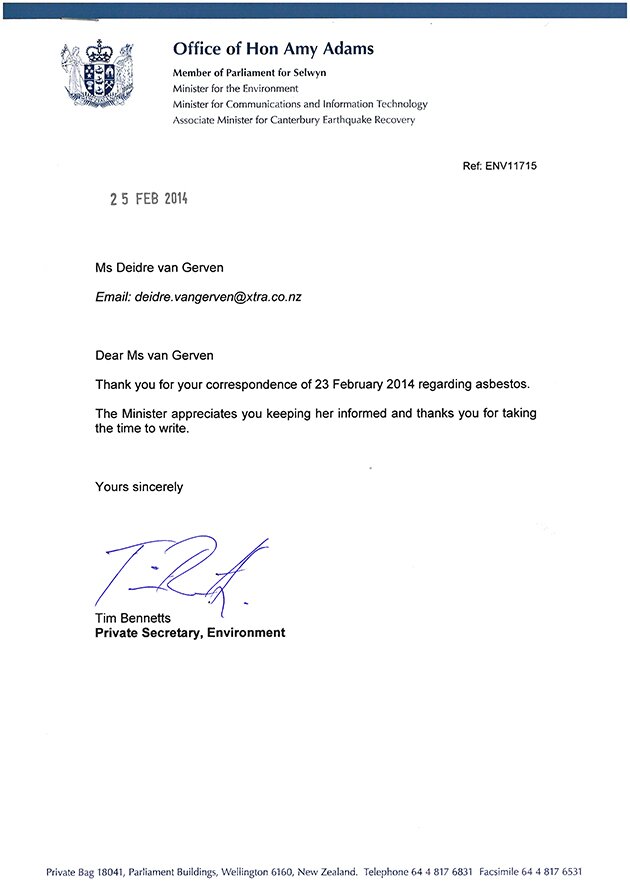
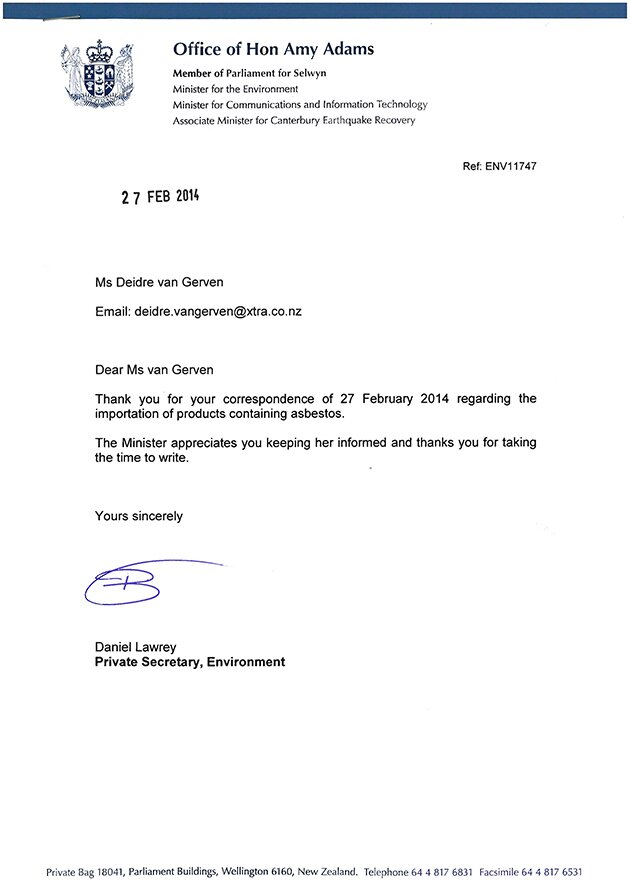
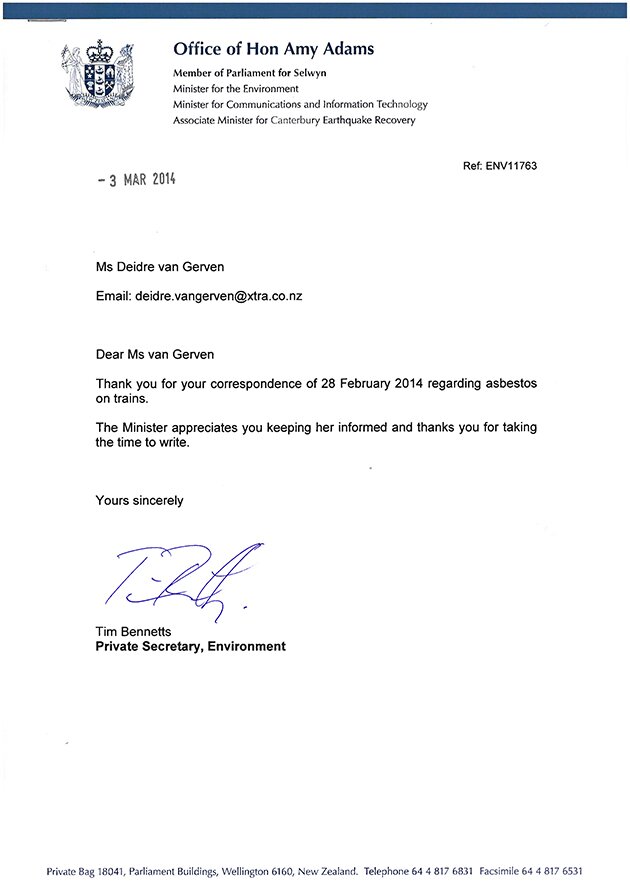

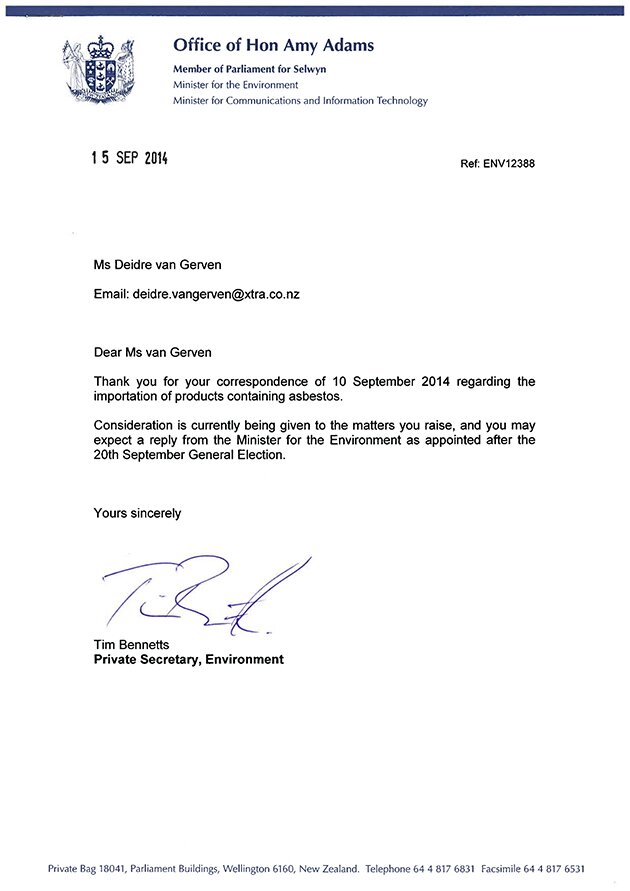


What shocked me as far as this last letter from Nick Smith goes is the fact we are not just importing these products but are also exporting them.
How can we be doing this if we do not manufacture such goods.
Does this mean we are bringing them into New Zealand and then sending them off to other countries.
To make that worthwhile they would have to be buying them cheap and putting a higher price on to the cost.
If this is so then it is disgusting.
Do the countries we are sending them onto know they are receiving products that contain asbestos.
We can't even trust the products that we do receive that say they are asbestos free.
Five years I have been asking them to ban all these products from entering New Zealand, and now I find we are sending them on to other countries.
It is not Okay. What is New Zealand coming to.?
Making a profit on a product that is known to kill people. On Saturday the 29th November I sent this reply back to Nick Smith.
Dear Nick,
In reply to your letter above I will await with bated breath to see this report listed on your web site in the near future.
I would like to think the near future means before you all take off for your Christmas break,
so I shall "pop in" periodically to see if you surprise me with an early Christmas gift. I mean lets face it.
Amy Adams first spoke of having an investigation started in November 2013
because there appeared to be a problem with her being able to put in place
a complete ban of all products containing asbestos.
So while I’m waiting for this report to show up I shall go back to the problem of the “ban” on all of these
products from entering or leaving NZ that I first put to you in 2009.
22nd OCT 2009
Office of Hon.
Dr. Nick Smith.
MP for Nelson
Minister for the Environment
Minister for Climate Change Issues
Minister for ACC.
Dear Deidre vanGerven,
Thank you for your email of 1st August 2009 to the Prime Minister regarding health risks from asbestos.
I am responding on behalf of the Prime Minister as the issues you raise touch on a number of Ministers' portfolios.
I am sorry to hear of your distressing first hand experiences and I agree with you that managing the potential effects of asbestos is important.
I can assure you that both the mining of asbestos in New Zealand and the import of any form of raw asbestos fibre into New Zealand has, for all practical purposes, been prohibited.
New Zealand factories stopped making building products containing asbestos back in the 1980s.
The focus now is ensuring the appropriate management and handling of historic
asbestos products that are still in use or have been disposed of.
This is mainly achieved through the Department of Labour (which manages asbestos in places of work) and through local authorities, who manage landfills and other sites where asbestos has been disposed of.
I knew about and was not part of my original mail so you can ignore that
Further, although some products containing asbestos are still able to be imported.
Suppliers of products containing asbestos must ensure that the products are labelled as such,
so that adequate precautions may be taken.
We know this is not working as products are still entering NZ labelled asbestos free and on testing are found to contain asbestos
As the use of asbestos-containing products is decreasing internationally, the government does not consider that further regulations of imports is required at this stage.
Also not quite true and in my opinion a real "cop out"
There are many more countries coming in line with the complete banning of asbestos in any form or manner but not the big manufacturers and producers of all forms of asbestos. So please do not use this as an excuse for "sitting on your hands and doing nothing" That is not good enough for the people of NZ .
The Department of Labour is the department that manages the potential risks from asbestos,
through the Health and Safety in Employment (Asbestos) Regulations 1998.
and the Guidelines for the Management and Removal of Asbestos. I suggest you contact them directly
If you take a look at those regulations and the new ones that are soon to be in force you will see that neither the home renovator or the products containing asbestos are part of that equation.
Even in the draft document on asbestos these two things are not covered by these regulations.
So you do need to do something about it.

---------------
On To Asbestos Related Diseases